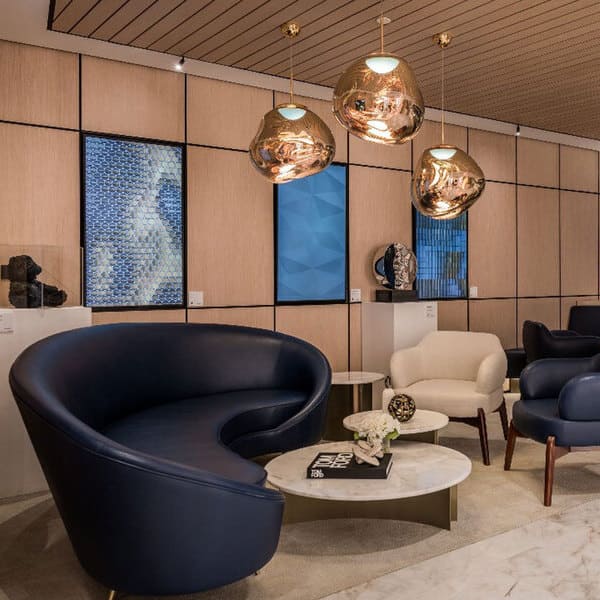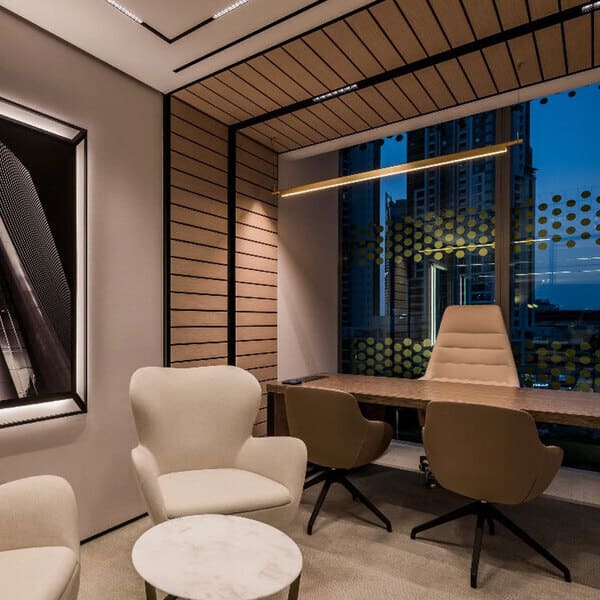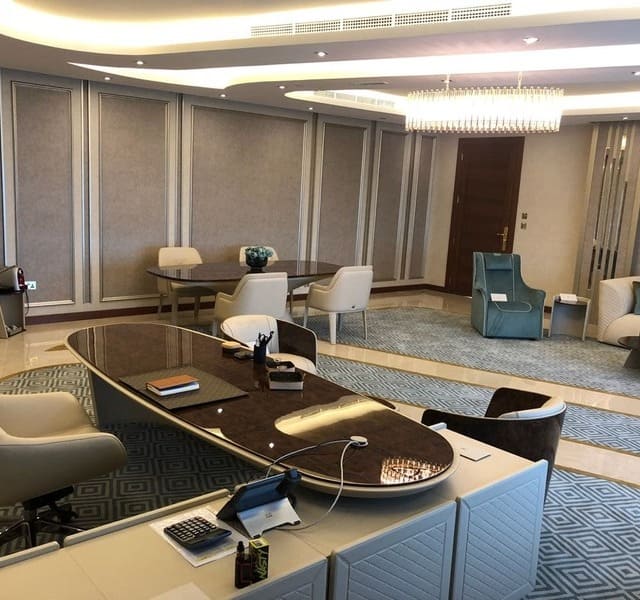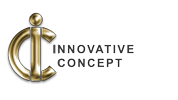In Dubai’s high-end office spaces, luxury design is no longer about obvious opulence. Instead, it has shifted into a language of refined control, silent authority, and visual intelligence. Beneath every surface, behind each carefully placed element, lies an intentional dialogue between materials, light, and spatial rhythm that only trained eyes often catch. Let’s examine the specific look-based strategies driving these luxurious modern offices — a world where status is communicated not through spectacle but through calibrated nuance.

Architectural Geometry as a Silent Statement
One of the most distinctive visual themes appearing in Dubai’s luxury offices is the intentional use of structural asymmetry. Instead of safe, straight-lined window glazing, some designs employ sharply slanted glass planes intersected by black steel braces. These diagonal divisions aren’t simply dramatic—they disrupt predictable sightlines and introduce an architectural tension that energizes otherwise static views of the urban skyline. The sliced geometry becomes part of the room’s art, framing Dubai’s towers as living background installations. This interaction between exterior cityscape and interior composition creates an invisible, but very real, sense of corporate authority and ambition.
Materials Speak Quietly But Powerfully
Material selection in these offices doesn’t aim for maximalism. It leans into textural restraint. Walnut veneers, brushed black metals, warm oak, muted taupes, and soft beiges dominate the palette. Each material carries weight not because of its rarity, but because of how it’s introduced:
- Walnut desks with their visible horizontal grains echo natural growth patterns, bringing understated richness.
- Black metal legs offer a skeletal frame, keeping the designs light, open, and intentional.
- Marble coffee tables balance hardness with quiet elegance through their fine veining, avoiding any loud visual presence.
- Brushed brass accents produce a soft glow rather than hard reflection, introducing warmth that interacts with both artificial and natural light.
What makes this approach distinctive is the absence of glossy, mirror-like finishes. Surfaces are usually matte or semi-matte, absorbing light rather than throwing it back harshly. This allows controlled reflection, guiding how the space feels under different lighting conditions.

Luxury Office Furniture: Curves Within Control
Seating choices often reveal one of the more sophisticated elements at play: the controlled use of organic curvature within a largely rectilinear architecture. Executive chairs offer tall, commanding profiles with vertical or gently horizontal stitched channels, suggesting structure without appearing stiff. In contrast, guest seating embraces softer forms—subtly curved backs and armrests wrapped in taupe or beige leather, low profiles that visually rest within the space rather than intrude.
Lounge spaces introduce a bolder curvature. Deep navy blue leather sofas curve with an almost mid-century influence, creating movement in otherwise linear layouts. Here, curvature becomes not only functional for conversation but also visual, breaking the grid-like tendencies of walls, ceilings, and floors. The result is an interior rhythm that feels alive but not chaotic.
Art as a Continuation of Architectural Themes
Rather than inserting unrelated artworks for decoration, these luxury offices curate art that extends the architecture itself. Black-and-white architectural photographs echo the exact linear or curved geometries found in window structures and wall treatments. Even when moving into digital or abstract art, pieces display geometric discipline: hexagonal gradients, polygonal facets, and deeply saturated blocks of blue or purple. These are not random decor choices — they mirror the office’s underlying design logic, building cohesion between function, form, and expression.
Layered Lighting: Light as Texture
Lighting plays a role far beyond illumination. It becomes its own design surface:
- Cone-shaped matte black pendants with white interiors focus light into disciplined circles, ensuring that workspaces feel both private and deliberate.
- Integrated linear backlighting outlines art installations and creates glowing seams along upholstered wall panels, turning otherwise flat surfaces into softly lit textural fields.
- Organic gold pendants, resembling molten droplets, inject fluidity into formal seating zones, reflecting both light and form back into the room, amplifying the perception of depth.
- Linear LED ceiling channels within slatted or gridded ceilings deliver shadowless brightness across large open-plan work zones, eliminating fatigue while keeping rhythm above eye level.
Each lighting decision contributes to controlling how surfaces behave visually under day and night conditions. Reflections are carefully managed. Direct glare is almost entirely absent. What remains is a sense of atmosphere that shifts subtly with time and use.
Ceiling Designs: The Silent Organizers of Space
Ceilings become powerful but often unnoticed design players. In private zones, slatted wood ceilings with horizontal runs balance the verticality of wall slats, allowing cross-directional visual interaction between different planes. This dynamic shift prevents the space from feeling boxy or constrained, even in smaller executive offices.
In larger work zones, acoustic ceiling grids with integrated lighting create an orderly, repeating pattern that softens sound while establishing a visual scaffold above open workstations. The ceiling here quietly manages the perceived vastness of the space, bringing human scale to large volumes.

Subtle Identity Through Privacy Treatments
Even privacy elements serve multiple visual roles. The use of yellow-dotted privacy films across glass walls introduces delicate branded patterning without heavy-handed logos or text. It filters exterior light and reflections while giving internal spaces an added layer of graphic precision. These patterns operate as subliminal brand expressions—visible, but never intrusive.
Color Balancing: Controlled Saturation Across Planes
Color across these Dubai offices is applied with surgical precision. Blue tones surface repeatedly but in controlled doses: on partition panels, lounge seating, and select artwork. These cool shades balance the warmth of woods and brass, preventing the space from tipping into sterility or overt coziness. The floors — often natural oak in pale tones — act as neutral anchors, while walls and partitions carry slightly richer or deeper colors, guiding the eye through layers of space.
The secret here is not to saturate entire rooms, but to distribute small controlled bursts of rich color across different surfaces and at varied eye levels, generating subtle depth without overwhelming the occupant.
Conclusion: Luxury by Visual Intelligence
In Dubai’s luxury modern office design, wealth is communicated less through flamboyance and more through visual discipline. Every line, material, and reflection is intentional. Curves are permitted, but only within grids. Rich materials are employed, but allowed to breathe. Lighting performs double duty as illumination and sculptural accent. And throughout it all, there’s a restrained, almost quiet confidence — the kind that whispers success rather than shouting it.
This is not simply office design. It is corporate identity translated into space — through an unspoken, carefully balanced visual language.
